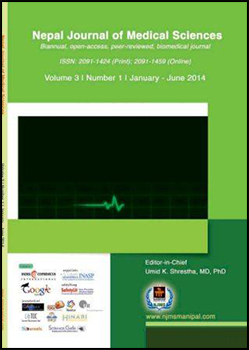Conventional vestibular function tests vs. butterfly vestibulometry in peripheral vertigo
DOI:
https://doi.org/10.3126/njms.v3i1.10355Keywords:
Butterfly vestibulometry, electronystagmography, peripheral vertigoAbstract
Background: To perform conventional vestibular function tests & butterfly vestibulometry via electronystagmography (E.N.G.) in patients diagnosed clinically as suffering from peripheral vertigo. To rule out the presence of a central lesion in clinically diagnosed patients of peripheral vertigo.
Methods: This is a prospective, cross-sectional, case series study conducted in 50 normal subjects and 138 patients clinically diagnosed as suffering from peripheral vertigo (excluding benign paroxysmal positional vertigo), who were subjected to conventional vestibular function tests &butterfly vestibulometry.
Results: Conventional bithermal caloric test identified a nystagmus in 13.04% patients while E.N.G. assisted bithermal caloric test identified anystagmus in 91.30% patients. Thus in our study the sensitivity of identifyinga nystagmus increased 7 times when comparing conventional bithermal caloric test to E.N.G. assisted caloric test. During E.N.G., amongthe pathological group 8.96% had normal response, 80.43% had a peripheral lesion, 7.97% had a central lesion and 2.89% had a non-localizing lesion. Among the control group 96% had normal response and 4% had a peripheral lesion. Among the 11 central causes of vertigo diagnosed by E.N.G., 4 cases were also diagnosed by M.R.I. of brain but in 7 cases(63.63%) no structural pathology was seen.
Conclusion: E.N.G. has 7 times more sensitivity to elicit nystagmus when compared to Fitzgerald Hallpike bithermal caloric test. E.N.G. can pick up central causes for vertigo amongst cases clinically diagnosed asperipheral vertigo. It has a better sensitivity to diagnose a central cause for vertigo when compared to M.R.I. of brain.
Nepal Journal of Medical Sciences | Volume 03 | Number 01 | January-June 2014 | Page 31-37
Downloads
Downloads
Published
How to Cite
Issue
Section
License
Copyright © by Nepal Journal of Medical Sciences. The ideas and opinions expressed by authors of articles summarized, quoted, or published in full text in this Journal represents only opinions of authors and do not necessarily reflect the official policy of Nepal Journal of Medical Sciences or the institute with which the author(s) is (are) affiliated, unless so specified.




